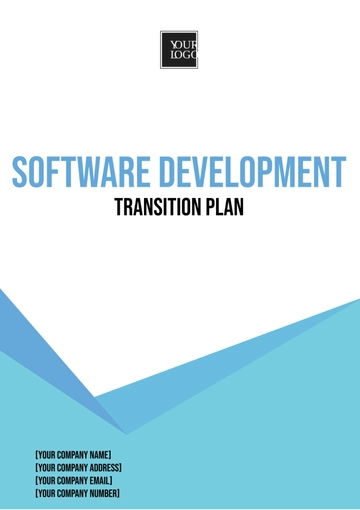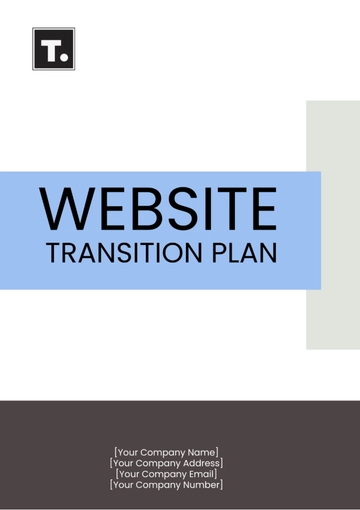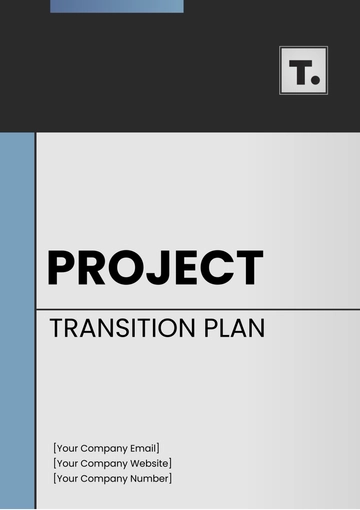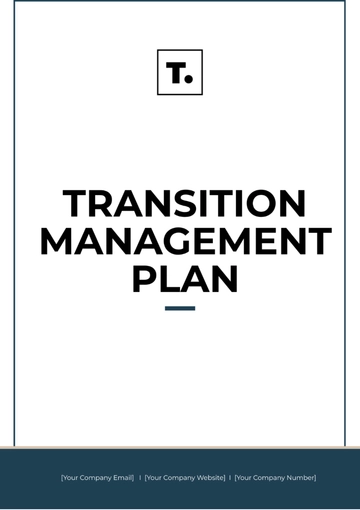Free Personnel Transition Plan

Prepared By: | [YOUR NAME] |
Date Prepared: | [DATE] |
I. Introduction
This Personnel Transition Plan Template offers a comprehensive and structured methodology for overseeing transitions among staff members within [Your Company Name]. The template is strategically crafted to facilitate a smooth and seamless shift of personnel roles and responsibilities, thereby upholding the organization's operational efficiency and ensuring uninterrupted continuity.
II. Contact Information
Company Name: [Your Company Name]
Company Email: [Your Email]
Company Social Media: [Your Company Social Media]
III. Objectives of the Transition Plan
Ensure minimal disruption to organizational operations: Minimize any negative impact on the company's functioning during personnel transitions, ensuring smooth continuity of activities.
Maintain clear communication with all involved parties: Ensure that all stakeholders are kept informed throughout the transition process, fostering transparency and understanding.
Outline responsibilities and timelines for each phase of the transition: Clearly define who is accountable for what tasks and when they need to be completed, ensuring clarity and alignment among team members.
Document training and support required for new personnel: Record the specific skills and knowledge new hires need, as well as the resources and assistance available to facilitate their successful integration into their roles.
IV. Key Stakeholders
Role | Name | Contact Information |
|---|---|---|
Transition Lead | [Transition Lead Name] | [Transition Lead Contact Information] |
HR Representative | [HR Representative Name] | [HR Representative Contact Information] |
Outgoing Personnel | [Outgoing Personnel Name] | [Outgoing Personnel Contact Information] |
Incoming Personnel | [Incoming Personnel Name] | [Incoming Personnel Contact Information] |
V. Transition Phases
A. Planning Phase
Define the scope and objectives of the transition:
Set clear goals such as filling vacancies, restructuring teams, or introducing new roles.
Identify impacted departments, teams, or individuals.
Ensure alignment with long-term organizational strategies.
Identify all stakeholders and communicate the plan:
List all involved parties: managers, HR, affected employees, executives.
Communicate roles, responsibilities, and expectations.
Provide a detailed overview of objectives, timeline, and necessary support.
Develop a detailed timeline and schedule:
Create a comprehensive timeline with key milestones.
Break down tasks into manageable phases.
Consider resources, dependencies, and risks.
Ensure realism and achievability.
B. Communication Phase
Distribute the transition plan to all stakeholders:
Ensure the transition plan is disseminated to all relevant stakeholders through appropriate channels, such as email or intranet.
Provide clear instructions on how stakeholders can access and review the plan.
Encourage stakeholders to ask questions and seek clarification if needed.
Hold initial meetings to discuss roles and expectations:
Schedule meetings with key stakeholders, including managers, HR representatives, and affected employees.
Use these meetings to discuss individual roles and responsibilities during the transition.
Clarify expectations for participation and cooperation throughout the process.
Address any concerns or uncertainties raised by stakeholders and provide reassurance and support as needed.
C. Implementation Phase
Start the handover process between outgoing and incoming personnel: Initiate the transfer of responsibilities and tasks from departing employees to their successors, ensuring a smooth transition of duties and knowledge.
Ensure all necessary documentation and knowledge transfer is complete: Verify that all relevant documents, procedures, and information are transferred from outgoing to incoming personnel to facilitate continuity and effectiveness in their roles.
Provide necessary training and support to incoming personnel: Offer comprehensive training and ongoing support to new employees to help them acclimate to their roles, learn job-specific tasks, and integrate into the team smoothly.
D. Monitoring Phase
Monitor the performance of incoming personnel during the transition period: Regularly assess the performance and progress of new employees to ensure they are effectively adapting to their roles and meeting expectations.
Adjust the plan as needed based on feedback and performance: Use feedback from monitoring to identify any areas where the transition plan may need adjustments or improvements, and make necessary modifications to optimize the transition process and ensure its success.
E. Conclusion Phase
Hold a debriefing meeting with all stakeholders to discuss the transition: Conduct a meeting involving all relevant stakeholders to reflect on the transition process, share insights, and address any concerns or feedback. This allows for open communication and helps identify successes and areas for improvement.
Document any lessons learned and areas for improvement: Record key takeaways from the transition process, including successes, challenges, and opportunities for enhancement. This documentation serves as valuable feedback for future transitions, aiding in continuous improvement and organizational learning.
VI. Timeline
Transition Phase | Key Milestones/Deadlines |
|---|---|
Planning Phase | - Define scope and objectives (Day 1) |
- Identify stakeholders (Day 3) | |
- Develop timeline (Day 5) | |
Communication Phase | - Distribute transition plan (Day 7) |
- Hold initial meetings (Day 10) | |
Implementation Phase | - Start handover process (Day 15) |
- Complete documentation transfer (Day 20) | |
- Provide training and support (Day 25) | |
Monitoring Phase | - Monitor incoming personnel (Day 30) |
- Adjust plan based on feedback (Day 35) | |
Conclusion Phase | - Hold debriefing meeting (Day 40) |
- Document lessons learned (Day 45) |
VII. Risk Management
Risk | Probability | Impact | Mitigation Strategy |
|---|---|---|---|
Communication breakdown | Medium | High | Regular status meetings and updates |
Incomplete knowledge transfer | High | High | Thorough documentation and double-checking |
Technical issues | Medium | High | IT support on standby and alternative channels |
Key personnel unavailability | Low | High | Designate backup personnel or cross-train staff |
VIII. Resources Required
Training materials and resources:
Develop tailored training materials covering essential skills and procedures.
Provide access to relevant online platforms and workshops.
Assign mentors for hands-on support.
Documentation and process guides:
Compile detailed SOPs and guidelines.
Ensure easy access to centralized documentation.
Regularly update documentation.
Access to necessary software and tools:
Provide access and permissions for required software.
Ensure personnel receive necessary training.
Offer technical support for troubleshooting.
- 100% Customizable, free editor
- Access 1 Million+ Templates, photo’s & graphics
- Download or share as a template
- Click and replace photos, graphics, text, backgrounds
- Resize, crop, AI write & more
- Access advanced editor
Manage personnel changes effectively with the Personnel Transition Plan Template from Template.net. This highly customizable and editable template helps you outline all critical steps for smooth personnel transitions. Editable in our AI Editor Tool, you can tailor the plan to fit your specific requirements. Maintain continuity and minimize disruptions with this comprehensive transition plan.
You may also like
- Finance Plan
- Construction Plan
- Sales Plan
- Development Plan
- Career Plan
- Budget Plan
- HR Plan
- Education Plan
- Transition Plan
- Work Plan
- Training Plan
- Communication Plan
- Operation Plan
- Health And Safety Plan
- Strategy Plan
- Professional Development Plan
- Advertising Plan
- Risk Management Plan
- Restaurant Plan
- School Plan
- Nursing Home Patient Care Plan
- Nursing Care Plan
- Plan Event
- Startup Plan
- Social Media Plan
- Staffing Plan
- Annual Plan
- Content Plan
- Payment Plan
- Implementation Plan
- Hotel Plan
- Workout Plan
- Accounting Plan
- Campaign Plan
- Essay Plan
- 30 60 90 Day Plan
- Research Plan
- Recruitment Plan
- 90 Day Plan
- Quarterly Plan
- Emergency Plan
- 5 Year Plan
- Gym Plan
- Personal Plan
- IT and Software Plan
- Treatment Plan
- Real Estate Plan
- Law Firm Plan
- Healthcare Plan
- Improvement Plan
- Media Plan
- 5 Year Business Plan
- Learning Plan
- Marketing Campaign Plan
- Travel Agency Plan
- Cleaning Services Plan
- Interior Design Plan
- Performance Plan
- PR Plan
- Birth Plan
- Life Plan
- SEO Plan
- Disaster Recovery Plan
- Continuity Plan
- Launch Plan
- Legal Plan
- Behavior Plan
- Performance Improvement Plan
- Salon Plan
- Security Plan
- Security Management Plan
- Employee Development Plan
- Quality Plan
- Service Improvement Plan
- Growth Plan
- Incident Response Plan
- Basketball Plan
- Emergency Action Plan
- Product Launch Plan
- Spa Plan
- Employee Training Plan
- Data Analysis Plan
- Employee Action Plan
- Territory Plan
- Audit Plan
- Classroom Plan
- Activity Plan
- Parenting Plan
- Care Plan
- Project Execution Plan
- Exercise Plan
- Internship Plan
- Software Development Plan
- Continuous Improvement Plan
- Leave Plan
- 90 Day Sales Plan
- Advertising Agency Plan
- Employee Transition Plan
- Smart Action Plan
- Workplace Safety Plan
- Behavior Change Plan
- Contingency Plan
- Continuity of Operations Plan
- Health Plan
- Quality Control Plan
- Self Plan
- Sports Development Plan
- Change Management Plan
- Ecommerce Plan
- Personal Financial Plan
- Process Improvement Plan
- 30-60-90 Day Sales Plan
- Crisis Management Plan
- Engagement Plan
- Execution Plan
- Pandemic Plan
- Quality Assurance Plan
- Service Continuity Plan
- Agile Project Plan
- Fundraising Plan
- Job Transition Plan
- Asset Maintenance Plan
- Maintenance Plan
- Software Test Plan
- Staff Training and Development Plan
- 3 Year Plan
- Brand Activation Plan
- Release Plan
- Resource Plan
- Risk Mitigation Plan
- Teacher Plan
- 30 60 90 Day Plan for New Manager
- Food Safety Plan
- Food Truck Plan
- Hiring Plan
- Quality Management Plan
- Wellness Plan
- Behavior Intervention Plan
- Bonus Plan
- Investment Plan
- Maternity Leave Plan
- Pandemic Response Plan
- Succession Planning
- Coaching Plan
- Configuration Management Plan
- Remote Work Plan
- Self Care Plan
- Teaching Plan
- 100-Day Plan
- HACCP Plan
- Student Plan
- Sustainability Plan
- 30 60 90 Day Plan for Interview
- Access Plan
- Site Specific Safety Plan





























